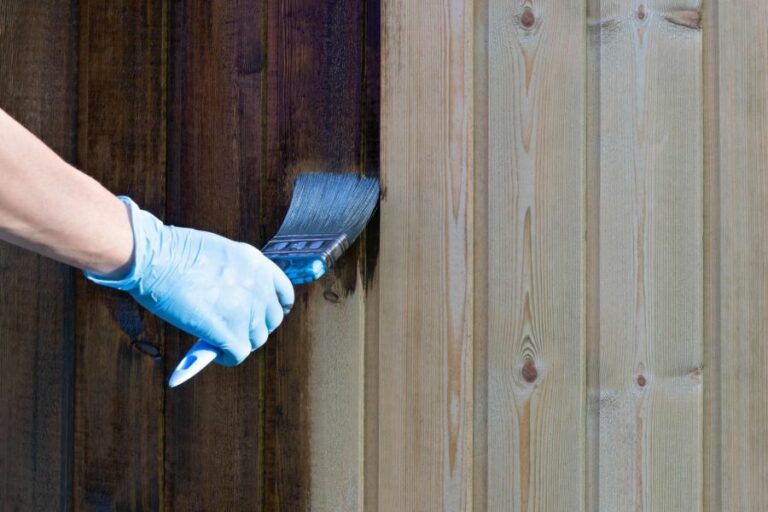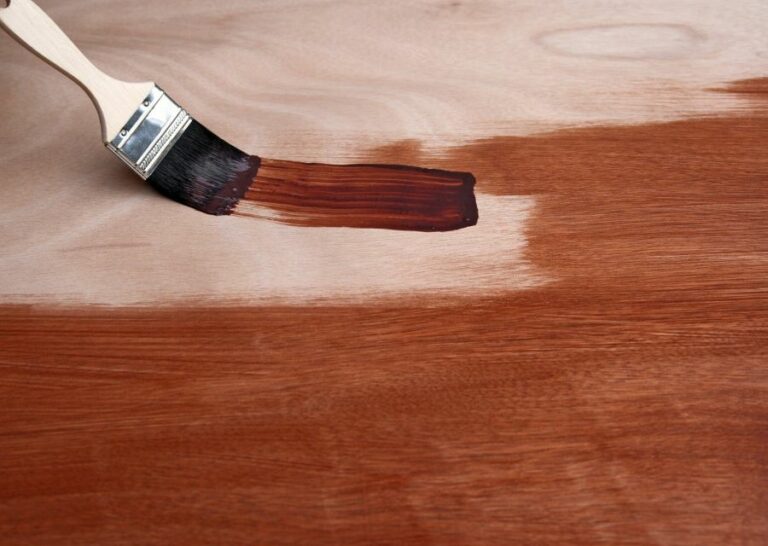Outdoor Paint For Wood Fence, 25 Things You Should Know
Brighten up your backyard oasis while safeguarding your wooden fence from the elements! Let’s delve into the perfect blend of aesthetics and protection to make your fence stand out. I’ve compiled an informative guide that compares various paint types, shares expert tips on color selection and proper application, and outlines the key factors to consider for long-lasting results.
Outdoor paint for a wood fence:
Outdoor wooden fences require proper care and maintenance for durability and longevity. The right high-quality outdoor paint enhances the appearance and protects from elements like sun, rain, and snow. Preparing the surface by cleaning, sanding, repairing damages, applying wood preservatives, and priming ensures proper adhesion and longer-lasting paint. Acrylic latex and oil-based paints are suitable for outdoor wood fences, with top recommendations including BEHR Premium Plus Exterior Paint & Primer, Sherwin-Williams Duration, and Valspar Storm Coat. Preparing the surface, selecting the right paint type, and following painting tips can lead to a long-lasting and beautiful fence.

Discover the best outdoor paint options for your wooden fence, prioritizing durability and weather resistance. Learn about different paint types, application techniques, and expert tips to ensure your fence stays vibrant for years to come. Keep reading!
Contents
- 1 Exterior Paint for Wooden Fences
- 2 What Type of Paint Should Be Utilized on a Wooden Fence?
- 3 What is the Most Suitable Type of Paint for Outdoor Fencing?
- 4 What is the Ideal Paint Choice for an Aging Wooden Fence?
- 5 Is it Possible to Apply Exterior Paint on a Wooden Fence?
- 6 Which Type of Finish is Most Suitable for Fence Paint?
- 7 What is the Most Suitable Paint for Exterior Wood Posts?
Exterior Paint for Wooden Fences
Outdoor wooden fences add an element of charm and privacy to your home, but they also require proper care and maintenance to ensure their durability and longevity. One of the best ways to protect and enhance the appearance of your wood fence is by applying high-quality outdoor paint.
• Why Choosing the Right Outdoor Paint Matters
Selecting the right outdoor paint for your wood fence is crucial for several reasons:
- Protection: Good quality exterior paint not only enhances the fence’s appearance but it also provides protection from the elements, such as sun, rain, and snow, preventing the wood from rotting, warping, or cracking.
- Longevity: The right paint can significantly extend the lifespan of your fence, reducing the need for expensive repairs or replacements in the future.
- Ease of maintenance: A properly sealed and painted fence will be easier to clean and maintain, saving you time and effort in the long run.
• Suggested Preparation Steps Before Painting
Before applying paint to your fence, it is essential to prepare the surface. This will ensure that the paint adheres properly and lasts longer. Here are some suggested steps to follow:
- Clean the fence: Remove any dirt, debris, and mildew from the surface using a stiff brush or pressure washer. Allow the fence to dry thoroughly before proceeding.
- Sand the surface: To ensure a smooth and even finish, lightly sand the fence using medium-grit sandpaper. This will also help remove any loose or peeling paint.
- Repair any damages: Inspect the fence for any damaged or rotting wood and replace or repair the sections as needed.
- Apply a wood preservative: Especially important for unpainted fences. Applying a wood preservative will protect the wood from rot and insects.
- Prime the fence: Use a high-quality exterior primer specifically designed for wood surfaces to improve paint adhesion and enhance the overall appearance of the paint job.
• Types of Paints for Outdoor Wood Fences
When selecting the best outdoor paint for your wood fence, consider the following types of paints:
– Acrylic Latex Paint
Acrylic latex paints are water-based, easy to clean up, and dry quickly. They provide excellent adhesion, durability, and resistance to the elements. These paints are also less prone to cracking, chipping, or peeling than oil-based paints.
Most acrylic latex paints are also environmentally friendly, with low volatile organic compounds (VOCs) levels.
– Oil-Based Paint
Oil-based paints are generally more durable and resistant to wear and tear compared to water-based paints.
However, they take longer to dry, emit higher levels of VOCs, and require the use of harsh chemicals for cleanup. Oil-based paints are suitable for high-traffic areas and where maximum durability is required.
• Top Outdoor Paints for Wood Fences
Based on personal experience and professional recommendations, here are some of the top outdoor paints for wood fences:
- BEHR Premium Plus Exterior Paint & Primer: This acrylic latex paint offers excellent durability, and the built-in primer ensures a smooth, even finish. It is available in various colors and finishes, allowing you to customize the look of your fence.
- Sherwin-Williams Duration: This premium acrylic latex paint offers excellent resistance to weathering and is self-priming, saving you time and effort during the painting process. It also comes with a lifetime limited warranty, providing peace of mind for your investment.
- Valspar Storm Coat: This 100% acrylic paint offers excellent adhesion, durability, and protection against the elements. The paint’s versatile finish allows it to work well on various surfaces, including wood fences.
• Tips for Painting Your Wood Fence
- Choose the right time to paint: Avoid painting during extremely hot or cold weather and when rain is expected. Optimal painting conditions are when the temperature is between 50F and 85F.
- Use the right tools: Using a high-quality brush, roller, or sprayer suitable for your chosen paint type will yield a more professional and consistent finish.
- Apply thin and even coats of paint: Avoid applying thick coats of paint all at once. Instead, apply thin, even coats, allowing each coat to dry according to the manufacturer’s instructions before applying the next coat.
- Regularly inspect your fence for damage or signs of wear and tear: Regular maintenance and prompt repairs will extend the life of your paint job.
In conclusion, choosing the right paint for your outdoor wood fence is essential to protecting and enhancing its appearance. Take the time to prepare the surface, choose the appropriate paint type, and follow the tips shared in this article for a long-lasting and beautiful fence.
What Type of Paint Should Be Utilized on a Wooden Fence?
Painting a wooden fence is an excellent way to both protect it and enhance its appearance. But with so many paint options available, how do you know which one to choose?
• Acrylic Latex Paint: A Popular Choice
Acrylic latex paint is a popular option for painting wooden fences due to its durability and ease of application. This water-based paint forms a flexible yet tough finish that can withstand exposure to various weather conditions without peeling or chipping.
Additionally, acrylic latex paint is quick-drying and has low VOC (volatile organic compounds) levels, which means it is environmentally friendly and safe to use.
– Key Features of Acrylic Latex Paint
- Durability: Acrylic latex paint provides a long-lasting finish that can stand up to harsh weather conditions and daily wear and tear.
- Low VOC: This paint type is a safer choice for both the environment and your health, thanks to its low VOC content.
- Easy to Clean: Acrylic latex paint is easily cleaned with soap and water, keeping your fence looking fresh and well-maintained.
- Fast Drying: This paint dries quickly, allowing you to complete your project in a short amount of time.
I recommend using high-quality acrylic latex paint for wooden fences. Depending on your aesthetic preferences, you may opt for a flat, satin, or semi-gloss finish.
• Oil-Based Paint: Long-Lasting and Vibrant
Oil-based paint is another suitable option for wooden fences. This type of paint contains natural oils that help it penetrate the wood and form a protective barrier. Oil-based paint is known for its durability and vibrant color offerings.
However, it does have a longer drying time and may be more challenging to clean up than acrylic latex paint.
– Key Features of Oil-Based Paint
- Superior Durability: Oil-based paint can last for many years without requiring frequent touch-ups, making it an excellent choice for your wooden fence project.
- Rich Colors: This paint type is known for its deep, vibrant hues, which can give your fence a unique and eye-catching appearance.
- Water Resistance: Oil-based paint creates a waterproof barrier that helps to protect your fence from moisture damage.
Be aware that oil-based paint has a strong odor and a higher VOC content than acrylic latex paint. Therefore, paint in a well-ventilated area and use appropriate protective gear, such as a mask and gloves, is essential.
• Solid Stain: An Alternative for a Natural Look
If you prefer a more natural look for your wooden fence, a solid stain might be the right choice for you. Solid stains can provide a similar level of protection as paints but have a thinner texture that highlights the wood grain. These stains are available in various colors and can either be water-based or oil-based.
– Key Features of Solid Stain
- Natural Appearance: Solid stains enhance the texture of the wood while providing an even, uniform color.
- UV Protection: Many solid stains offer excellent UV protection, shielding your fence from color fading caused by the sun.
- Moisture Resistance: Like paint, solid stains can help protect your wooden fence from water damage.
Remember that solid stains may require more frequent reapplication than paint, as their protective properties may diminish over time.
• Prepare Your Fence for Painting
Before applying paint or stain to your wooden fence, it is crucial to prepare the surface properly. Follow these steps to ensure a smooth application and long-lasting results:
- Clean the Surface: A clean and dry surface is essential for proper paint or stain adherence. Use a power washer or a stiff brush and a detergent solution to clean your fence. Allow your fence to dry completely before proceeding.
- Remove Old Finish: If your fence has any old paint or stain, remove it using a paint scraper or a chemical paint stripper.
- Sand the Surface: Sand your fence with medium-grit sandpaper (e.g., 120-grit) to create a smooth and even surface.
- Apply Primer: Applying a good-quality primer can improve the adhesion of paint or stain to your fence and enhance its protective properties. Choose a primer that is compatible with your chosen paint or stain.
By selecting the right paint or stain for your wooden fence and adequately preparing the surface, you can create a beautiful, long-lasting finish that protects your fence and enhances its aesthetic appeal.
Paint Type | Description |
|---|---|
Acrylic | Acrylic paint is water-based and provides a durable finish. It is UV resistant and easy to clean. |
Latex | Latex paint is also water-based and provides a long-lasting finish. It is resistant to moisture and mildew. |
Oil-based | Oil-based paint is known for its durability and strong adhesion to wood surfaces. It is resistant to moisture and provides a rich finish. |
Wood stain | Wood stain is not technically paint, but it provides color and protection to the wooden fence. It is available in various shades and enhances the natural grain of the wood. |
Wood preservative | Wood preservative is a protective coating that helps prevent rot and decay. It can be clear or tinted and is often used as a primer before applying paint or stain. |
What is the Most Suitable Type of Paint for Outdoor Fencing?
An outdoor fence is more than just a boundary separator; it can be a functional addition to your property, offering privacy and adding an aesthetic appeal. To ensure a long-lasting, durable and attractive finish, choosing the right paint for your outdoor fence is essential.
• Top Factors to Consider When Choosing Paint for Outdoor Fences
Before diving into the different types of paints available, let’s first take a look at the critical factors to consider when choosing paint for your outdoor fence.
– Weather Resistance
The paint you choose must be capable of withstanding harsh weather conditions, including rain, snow, humidity, and extreme temperatures.
– Durability
The paint should be long-lasting and resistant to peeling, fading, and chipping. Maintaining your outdoor fence can be time-consuming and costly, so investing in durable paint will save you time and money in the long run.
– Ease of Application
Some paints are more comfortable to apply than others, which can influence your decision when choosing a paint, especially if you plan on doing the job yourself.
– Color Retention
The paint should have excellent color retention properties, ensuring that it maintains its vibrant and fresh appearance for as long as possible.
• Best Types of Paints for Outdoor Fences
Now that you have a better understanding of what to look for in an outdoor fence paint let’s explore some of the best options available on the market.
– Acrylic Latex Paint
In my experience, acrylic latex paint is an excellent option for painting outdoor fences. It’s a water-based paint that’s easy to apply and clean up, making it an ideal choice for DIY projects. Acrylic latex paint is also incredibly durable and resistant to fading, peeling, chipping, and mildew growth.
One of the main advantages of acrylic latex paint is that it offers excellent adhesion to various surfaces, including wood, metal, and vinyl fencing.
It also dries quickly and maintains its color and finish for a longer period than other paints, minimizing the need for frequent touch-ups or reapplication.
I recommend choosing a high-quality, weather-resistant acrylic latex paint for your outdoor fence. Brands such as BEHR, Sherwin-Williams, and Benjamin Moore are well-known for producing premium, long-lasting exterior paints.
– Oil-Based Paint
Oil-based paint is another reliable option for painting outdoor fences. It offers superb adhesion and durability, making it an excellent choice for fences that are exposed to harsh weather conditions.
However, oil-based paint has a longer drying time than acrylic latex paint and can be more challenging to clean up, as it requires solvents such as mineral spirits.
One possible drawback of oil-based paint is that it may emit strong odors during application, making it less suitable for those sensitivities to smells. However, its impressive durability and weather-resistant properties make it a strong contender for the best paint for outdoor fences.
When choosing an oil-based paint for your fence, I recommend opting for a reputable brand to ensure top-notch performance and longevity.
– Exterior Stain
While not technically paint, an exterior stain is worth considering for your outdoor fence. Instead of forming a layer on the surface like paint, a stain penetrates the wood or other porous materials, offering deep protection and a natural finish.
Stains are available in a variety of formulations, including water-based, oil-based, and hybrid varieties. The most suitable option for your fence will depend on your specific requirements, such as the type of material the fence is made from and the desired level of protection against weather and UV exposure.
One advantage of using a stain for your outdoor fence is that it can enhance the natural beauty of wood or other material. If you prefer a more rustic, natural appearance, a stain might be the perfect choice for you.
However, remember that a stain offers a less comprehensive, opaque finish than paint, so it may not conceal imperfections.
When selecting an exterior stain for your fence, I recommend considering a reputable brand like Cabot, Olympic, or Thompson’s WaterSeal to ensure effective protection and an attractive finish.
• Final Thoughts on the Best Paint for Outdoor Fences
The best paint for your outdoor fence ultimately depends on several factors, including the type of material your fence is made from, your desired finish, and the level of protection needed against harsh weather conditions.
In my experience, acrylic latex paint is a standout choice due to its ease of application, durability, and weather resistance. However, oil-based paint and exterior stains also offer excellent protective qualities that may be better suited to your fence’s specific needs.
Do thorough research and consult with professionals if needed to ensure you make the best decision for your outdoor fence paint.
Paint Type | Durability | Weather Resistance | Maintenance | Price Range |
|---|---|---|---|---|
Acrylic Latex | Very Durable | High | Low | $$ |
Oil-Based | Durable | High | Moderate | $$$ |
Water-Based Stain | Moderately Durable | Moderate | Low | $ |
Solid Color Stain | Durable | High | Low | $$ |
What is the Ideal Paint Choice for an Aging Wooden Fence?
As an expert in painting and home maintenance, people often seek advice on what paint is best for their old wood fences. A well-maintained fence protects the property and enhances its overall aesthetics.
Make no mistake, selecting the right paint for old wood fences can be quite challenging, especially with so many available options.
• Preparing the Fence for Painting
Before discussing the best paint options, it’s essential to understand the importance of preparing the old wood fence for a new coat of paint. Proper preparation ensures that the paint adheres optimally to the fence, providing long-lasting protection and a great finish.
– Cleaning the Wood Fence
First and foremost, the old wood fence must be cleaned to remove dirt, mildew, and algae. A pressure washer or a soft brush can be used to clean the fence effectively. Allow the fence to dry for 24-48 hours before moving on to the next steps.
– Repairing Damaged Wood
Examine the fence for any damaged or rotten wood that requires repair or replacement. Use wood filler to fill any holes or cracks and sand the area to create an even surface.
– Sanding the Surface
Sanding removes any remaining old paint, creating a smooth surface that enhances the new paint’s adhesion. Use medium-grit sandpaper for the best results, and make sure to sand in the direction of the wood grain.
– Applying Primer
Applying a high-quality primer is crucial for the best outcome. It improves paint adhesion and prevents any stains or discoloration from appearing through the new paint. Use a primer specifically formulated for old wood fences and cover the entire surface evenly.
• Acrylic Latex Paint
Due to its many advantages, acrylic latex paint is a top recommendation for old wood fences. This paint type combines the best acrylic and latex properties, offering excellent durability and coverage while easily cleaning up with water.
– Benefits of Acrylic Latex Paint
- Durability: Acrylic latex paint is known for its excellent resistance against weather conditions, mold, and mildew, making it perfect for outdoor fences.
- Quick Drying: This type of paint dries relatively quickly, allowing you to apply multiple coats in a shorter time.
- Easy Cleanup: Acrylic latex paint is water-soluble, making the cleanup process hassle-free.
– Drawbacks of Acrylic Latex Paint
- Quality: Lower-quality acrylic latex paints may not provide the desired coverage or durability. Opt for a reputable brand to ensure the best results.
• Oil-Based Paint
Another popular option for old wood fences is oil-based paint. These paints contain a solvent that evaporates as the paint dries, leaving behind a hard-wearing finish.
– Benefits of Oil-Based Paint
- Durability: Oil-based paints are known for their long-lasting finish and excellent resistance to chipping and peeling.
- Rich Color: These paints generally offer deeper and richer colors compared to water-based paints.
– Drawbacks of Oil-Based Paint
- Longer Drying Time: Oil-based paints often take longer to dry, requiring more time between coats.
- Cleanup: Cleaning brushes and equipment can be more challenging as you’ll need a paint thinner or mineral spirits.
• Solid Color Stain
Solid color stain is an alternative to traditional paint options, providing the best of both worlds: the vibrant color of paint and the benefits of a stain.
– Benefits of Solid Color Stain
- Penetrates Deep: Unlike paints, which create a layer on the surface, solid color stains penetrate deeper into the wood. This results in better protection and durability.
- Preserves Wood Texture: Stains allow the natural texture of the wood to show through, giving a more natural and aesthetically pleasing look.
– Drawbacks of Solid Color Stain
- Less Color Options: Solid color stains generally lack the wide range of color options available in traditional paints.
• Conclusion
Ultimately, the best paint for old wood fences depends on your specific needs and preferences. Acrylic latex paint offers durability, quick drying, and easy cleanup, while oil-based paints provide unmatched resistance to chipping and peeling. Solid color stains provide a durable and natural-looking finish.
I recommend trying acrylic latex paint for its numerous benefits, especially if you are working on a DIY project or prioritizing the ease of application and cleanup.
On the other hand, if you prefer a deeper color or the fence has heavy exposure to severe weather conditions, oil-based paint may be the right choice. Finally, if you love the look of a stained wood fence, solid color stains are an excellent compromise between traditional paint and wood stains.
Remember, proper preparation, high-quality materials, and adequate application techniques significantly achieve the desired results. Now that you have all the information at hand, it’s time to make the right choice and restore the beauty of your old wood fence.
Paint Type | Advantages | Disadvantages |
|---|---|---|
Acrylic Latex | Easy to clean, less VOCs, quick drying, and water resistant | May not adhere well to very old wood surfaces |
Oil-based | Long-lasting, durable, and better penetration into wood grain | Higher VOCs, longer drying time, and difficult to clean |
Exterior Stain | Enhances wood appearance and provides protection from weathering | Less coverage than paint, may need to be reapplied more frequently |
Paint and Primer in One | Convenient application, saves time, and provides good coverage | May not offer the same level of protection as separate primer and paint |
Is it Possible to Apply Exterior Paint on a Wooden Fence?
The simple answer is yes: you can paint a wood fence with exterior paint. However, there are essential factors to consider, steps to follow, and specific tools and materials needed to get the job done right.
• Why Paint a Wood Fence?
Aside from aesthetics, painting your wood fence with exterior paint provides the wood with added protection against the elements, such as:
- Preventing rot and decay caused by moisture
- Protecting the wood against harmful UV rays from the sun
- Deterring insects, like termites or wood-boring beetles, from damaging the wood
In addition, a well-maintained wood fence can increase your property’s curb appeal and potentially its overall value.
• Choosing the Right Exterior Paint for Your Wood Fence
Before you begin, it is important to select the appropriate exterior paint for your wood fence. There are two main types of exterior paint to choose from oil-based or water-based (latex) paint.
– Oil-Based Paint
Oil-based paint is durable and provides a tough, long-lasting finish. It is resistant to both moisture and UV rays. However, it can take longer to dry and may emit strong fumes while it does so. Moreover, cleaning up after using oil-based paint typically requires solvents like paint thinner.
– Water-Based (Latex) Paint
Water-based or latex paint is a popular choice for wood fences because it is easy to apply, quick to dry, and emits fewer fumes compared to oil-based paint. It is also easier to clean up, typically requiring only soap and water.
Also, latex paint tends to be more flexible, less prone to cracking and peeling.
While both types of paint offer their advantages, I recommend using water-based exterior paint for your wood fence because of its ease of use and flexibility, helping to provide long-lasting protection.
• Preparing Your Wood Fence for Painting
Before applying any paint, it is crucial to properly prepare the wood fence to ensure the paint adheres effectively and the final result is visually appealing. Follow these essential steps:
1. Inspect and Repair
Begin by inspecting your wood fence for any signs of structural damage, like loose or broken boards, and make necessary repairs. Additionally, look for rusted nails or rusty hardware and replace them as needed.
2. Clean the Wood
Clean your wood fence thoroughly to remove dirt, mildew, and other residues. Use a pressure washer with a low-pressure nozzle or a garden hose with an adjustable nozzle to rinse the entire surface. Allow the wood to dry completely before proceeding to the next step.
3. Sand the Surface
Sanding the wood fence ensures a smooth surface and removes any old paint or finish traces. Use medium-grit sandpaper (80-120 grit) and a sanding block or an electric sander to smooth the entire surface.
The smoother the surface, the better the paint will adhere. After sanding, use a damp or tack cloth to remove dust.
4. Apply a Wood Primer
A high-quality primer is essential for sealing the wood surface and providing better adhesion for the paint. Apply a wood primer according to the manufacturer’s instructions using a brush, roller, or sprayer. Allow the primer to dry completely before moving on to painting.
• Painting Your Wood Fence
It’s time to apply the exterior paint with the fence properly prepared. Follow these steps for a successful painting job:
1. Choose the Right Weather Conditions
The ideal temperature for painting outdoor wood is between 50F and 75F, with low humidity levels. Avoid painting during hot, humid, or windy weather conditions, as this can negatively affect the paint’s ability to dry properly and adhere correctly to the wood.
2. Use the Right Tools
Choose brushes or rollers that are specifically designed for applying exterior paint. If using a roller, select one with a medium nap (3/8 to 1/2 inch) for best coverage on wood surfaces.
3. Apply the Paint
Stir the paint thoroughly before applying it to the fence. Use long, even strokes, working from the top of the fence downward, ensuring an even layer of paint. Pay close attention to corners, seams, and edges, where rot and decay are more likely to occur.
Allow the paint to dry completely (check manufacturer recommendations for drying times) before applying a second coat if needed.
4. Clean Up and Dispose of Waste Properly
After completing the painting job, clean brushes, rollers, and other tools properly. Dispose of paint waste, like paint cans or used rags, in accordance with local regulations.
• Final Thoughts
Painting a wood fence with exterior paint enhances its appearance and provides valuable protection against the elements.
By following the steps and recommendations presented in this article, you’ll achieve a long-lasting and attractive finish for your wood fence, adding curb appeal and function to your property.
Question | Answer |
|---|---|
Can you paint a wood fence with exterior paint? | Yes |
Which Type of Finish is Most Suitable for Fence Paint?
A well-painted fence enhances the aesthetic appeal of your property and protects it from the elements. However, with the myriad paint finishes available in the market, making the right choice can be daunting.
• Understanding Paint Finishes
Paint finishes refer to the glossiness or shine of the paint. The level of glossiness in a paint largely determines its durability, ease of cleaning, and overall appearance. There are several types of paint finishes, each offering unique benefits and drawbacks.
When it comes to fence painting, the finish you choose directly impacts the longevity and maintenance of your fence.
– Matte Finish
Matte finish, also known as a flat finish, is a no-shine or low-gloss finish that provides an even and subtle appearance. It is ideal for concealing imperfections and promoting a uniform color distribution on your fence.
The matte finish is highly porous, which helps it absorb and hold color well, ensuring that your fence remains visually appealing for a long time.
However, matte finish paints are not highly durable and may require more frequent touch-ups. Moreover, they are not very easy to clean and can be easily stained due to their highly porous nature.
– Eggshell Finish
Eggshell finish lies between matte and satin finishes, offering a slight sheen without being too glossy. This finish is popular for its ability to withstand moderate wear and tear while maintaining a soft, natural appearance.
It hides surface imperfections well, and its less porous nature makes it more resistant to staining than matte finish paints.
Eggshell finish is an excellent choice for fences that need a balance between durability and visual appeal. However, it might not be suitable for high-traffic or high-touch areas as it can be susceptible to scratches and scuffs.
– Satin Finish
Satin finish offers a subtle shine that is more durable than both matte and eggshell finishes. This finish is highly resistant to moisture, making it an ideal choice for areas prone to humidity and dampness. Satin finish also allows for easy cleaning without causing damage to the paint surface.
The higher sheen of the satin finish makes it a popular choice for fence painting projects where homeowners want to add a touch of elegance and sophistication to their property. However, it may highlight surface imperfections more than matte or eggshell finishes.
– Semi-Gloss Finish
Semi-gloss finish is a step above satin finish in terms of shine and durability. It offers excellent protection against moisture and is highly resistant to wear and tear. Semi-gloss paint is easy to clean and can withstand frequent scrubbing without fading or losing its sheen.
However, the increased glossiness of a semi-gloss finish tends to amplify surface imperfections. This makes it a poor choice for old or damaged fences with noticeable wear and tear.
– High-Gloss Finish
High-gloss finish is the most durable and shiny option among paint finishes. It offers superior resistance to moisture, staining, and chipping. The high-gloss finish also allows easy cleaning and maintenance, requiring minimal touch-ups.
However, the reflective nature of the high-gloss finish makes it unsuitable for fences with surface imperfections. Additionally, it may appear overly shiny and reflective for some homeowners, making it less popular for fence painting, where a more subtle and natural appearance is preferred.
• Factors to Consider When Choosing a Fence Paint Finish
– Durability
When selecting a finish for your fence, durability should be a top priority. A durable paint finish will last longer and require less maintenance.
Glossier finishes, such as semi-gloss and high-gloss, are more durable and well-suited for fences that experience high wear levels, moisture exposure, or direct sunlight.
– Maintenance
The level of maintenance required for a paint finish is also an essential consideration. Glossier finishes, like semi-gloss and high-gloss, require less maintenance and can be wiped clean easily. In contrast, matte and eggshell finishes may require more frequent touch-ups due to their lower durability.
– Aesthetic Appeal
The choice of paint finish also impacts the overall appearance of your fence. Matte, eggshell, and satin finishes offer a more natural and subtle look, while semi-gloss and high-gloss finishes can add a touch of sophistication and elegance.
• Conclusion
In conclusion, the best paint finish for your fence depends on various factors like durability, maintenance, and aesthetic appeal.
Matte, eggshell, or satin finishes are recommended for a natural and subtle appearance. For higher durability and moisture resistance, semi-gloss or high-gloss finishes are the better choices.
Ultimately, the choice lies in balancing the desired look and functional benefits of a particular paint finish. So, carefully assess your fence painting needs and choose a paint finish that best meets your requirements.
Finish | Description | Benefits |
|---|---|---|
Flat or matte | A non-reflective finish with a smooth texture. | Conceals surface imperfections and can provide a uniform result. |
Satin | A subtle luster finish that has a slight sheen. | Resistant to mildew, dirt and moisture, making it easier to clean. |
Semi-gloss | A finish with a moderate sheen that provides some reflection. | Durable and holds up well against weather, stains and mildew. Easier to maintain than flat finishes. |
Gloss | A highly reflective finish that provides a shine. | Offers maximum durability and resists chipping, cracks, and peeling. Easiest finish to clean. |
What is the Most Suitable Paint for Exterior Wood Posts?
When it comes to protecting outdoor wood posts, the right paint is essential. It not only enhances the appearance but also preserves the quality of the wood.
• Why Use Specific Wood Paint
Wood posts are exposed to various elements such as rain, sun, and temperature fluctuations. Using the right paint helps protect the wood against moisture, rot, and other weather-induced damage. Quality paints create a barrier that maintains structural integrity and extends the life of the wooden post.
• Types of Paint for Outdoor Wood Posts
There are mainly three types of paint that are suitable for outdoor wood posts: oil-based, water-based, and acrylic-based paints. Each type has its pros and cons, and the best choice largely depends on your specific requirements and preferences.
– Oil-based Paints
Oil-based paints are highly resistant to moisture and provide excellent adhesion to surfaces. They are known for their durability and long-lasting protection. However, they require a longer drying time and produce a strong odor during application.
Pros
- Highly resistant to moisture
- Excellent adhesion properties
- Durable and long-lasting protection
Cons
- Longer drying time
- Strong odors during application
- Harsher on the environment due to higher VOCs (volatile organic compounds)
– Water-based Paints
Water-based paints are environmentally friendly with low VOCs. They are easy to clean up and have a quicker drying time. However, they are not as durable as oil-based paints and may require more frequent reapplication.
Pros
- Environmentally friendly with low VOCs
- Easy cleanup using water and soap
- Faster drying time
Cons
- Not as durable as oil-based paints
- May require more frequent reapplication
- Can be less effective in high-moisture environments
– Acrylic-based (Latex) Paints
Acrylic-based paints are also known as latex paints. They are a popular choice due to their durability, flexibility, and ease of application. These paints provide good moisture resistance and are suitable for various weather conditions.
Pros
- Durable and long-lasting protection
- Good moisture resistance
- Suitable for different weather conditions
- Easy to apply and clean up
Cons
- May require a primer for better adhesion
- Can be prone to peeling if not applied correctly
- Slightly higher cost in comparison to other types of paint
• Factors to Consider When Choosing Paint for Outdoor Wood Posts
When selecting the best paint for your outdoor wood posts, consider the following factors:
- Durability: Opt for paints that offer long-lasting protection against weather-related damage.
- Moisture resistance: Choose a paint that can withstand moisture and prevent rot.
- UV resistance: Select a paint that offers protection against the sun’s UV rays to prevent fading and discoloration.
- Ease of application and cleanup: Ensure the paint is easy to apply and clean up after use.
- Environmental impact: Consider using eco-friendly paints with low VOCs to minimize the environmental impact.
• Top Paint Recommendations for Outdoor Wood Posts
Based on the factors outlined above, here are some top paint recommendations for outdoor wood posts:
- Rust-Oleum Painter’s Touch Ultra Cover: This acrylic-based latex paint is durable, UV-resistant, and easy to apply, making it ideal for outdoor wood posts.
- Behr Premium Plus Exterior Paint & Primer: This premium water-based paint offers excellent coverage, adhesion, and moisture resistance.
- Sherwin-Williams SuperPaint Exterior Acrylic Latex: This high-quality paint provides excellent durability and protection against harsh weather conditions.
• Tips for Painting Outdoor Wood Posts
Here are a few helpful tips to ensure a successful paint job on your outdoor wood posts:
- Clean the wood surface thoroughly to remove dirt, mildew, and loose paint.
- Sand the surface to ensure proper adhesion of the paint.
- Use a primer when necessary, especially for untreated wood or when using water-based paints.
- Apply multiple thin coats of paint, allowing each coat to dry before applying the next.
- Regularly inspect and maintain your painted wood posts to ensure they continue to look great and function well.
In conclusion, choosing the right paint for your outdoor wood posts is crucial for both their appearance and longevity. Consider factors such as durability, moisture resistance, and environmental impact when making your decision.
Regardless of the paint type you choose, proper preparation and application techniques are essential for a successful and long-lasting paint job.







